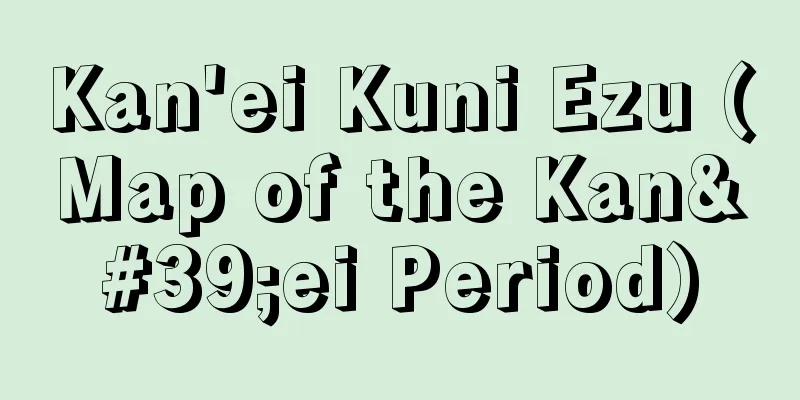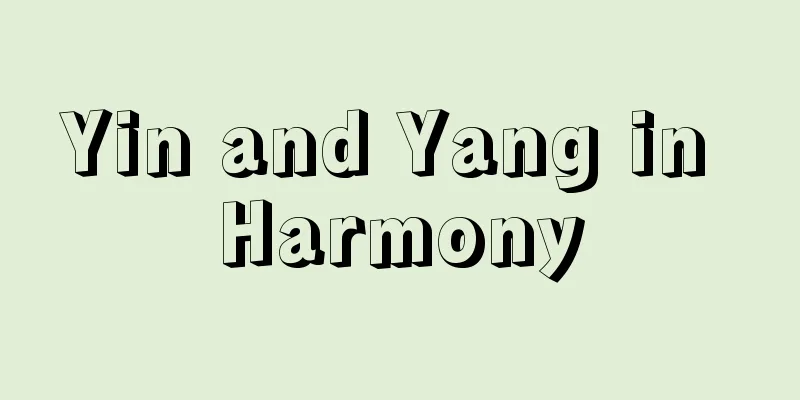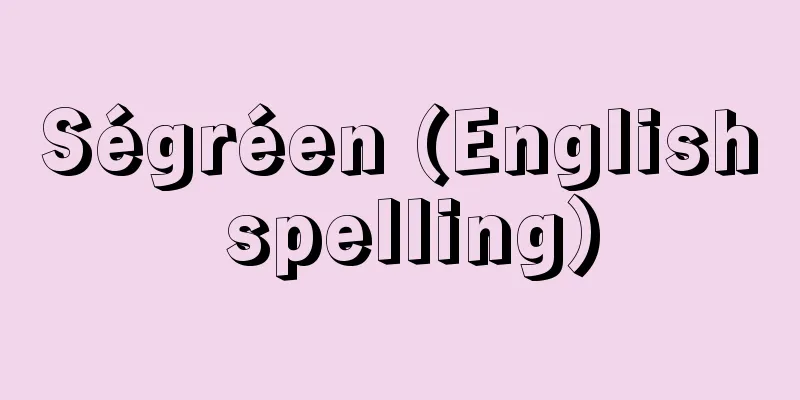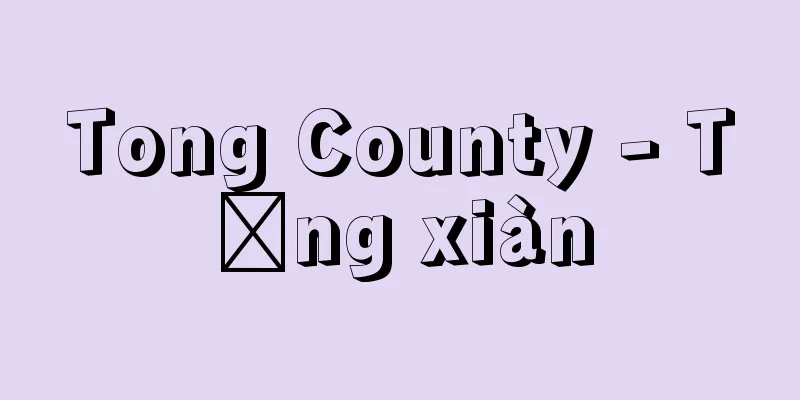Kango trade

|
Official trade conducted between the Ming Dynasty and Asian countries from the end of the 14th century to the 16th century through tangou ships. It is also called tangou ship trade. The Ming Dynasty implemented a maritime ban policy, prohibiting free travel and trade between its own and foreign ships, and only allowing trade to ships with tangou. The Japan-Ming trade by the Muromachi Shogunate was one such example, and was carried out as follows: [Yuko Ikegami] The beginning of tradeIn May 1401 (Oei 8), Ashikaga Yoshimitsu sent an envoy to Ming, with Soa as the chief envoy and Hakata merchant Koitsumi as the deputy envoy, to request the establishment of formal diplomatic relations. On this occasion, Yoshimitsu presented the Ming emperor with many gifts, including 1,000 ryo of gold and 10 horses, and sent back the castaways (who were actually captured by wako pirates). The envoy returned to Japan the following year accompanied by a Ming envoy, and delivered a letter from Ming. Then, in 1403, Kenchu Keimitsu of Tenryuji Temple became the chief envoy and entered Ming China, and the following year, the Ming envoy accompanied Yoshimitsu on his return to Japan, where he was given the first gold seal of Emperor Yongle, engraved with the kango and the "seal of the King of Japan." Thus, ships sent to Ming China or ships sent to Ming China traveled to Japan almost every year until 1410, and Ming ships also traded with Japan. After that, Shogun Ashikaga Yoshimochi broke off diplomatic relations with Ming China, but after a hiatus of more than 20 years, diplomatic relations were restored under Shogun Yoshinori. In 1432 (Eikyō 4), five ships sent to Ming China were sent, with the naturalized Ming monk Ryushitsu Doen as the chief envoy. The following year, five more ships from Ming China accompanied the envoys on their return to Japan, bringing with them the kango of Xuandoku, but this was the last time that Ming ships would visit Japan. [Yuko Ikegami] Management of the Ming Dynasty shipsThe operation of the ships to Ming was carried out by the shogunate, shugo daimyo such as Yamana, Ouchi, Hosokawa, and Shiba, and temples such as Tenryu-ji, Shokoku-ji, and Daijo-in. Because the profits were enormous, the number of ships increased to six in 1434 and nine in 1451 (Hōtoku 3), and the number of people and trade goods also increased, so the Ming Dynasty changed to a policy of restricting this, and thereafter set a limit of one tribute payment per ten years, three ships, and 300 people. As a result, the next three ships to Ming were ships of the shogunate, Hosokawa, and Ouchi, and in the seven subsequent dispatches of ships to Ming, the Ouchi and Hosokawa clans fiercely fought over the operation of the ships. In 1523 (Taei 3), the two sides clashed in Ningbo, resulting in burning and killing (the Ningbo Rebellion). In 1547 (Tenbun 16), the Ouchi clan sent four ships to Ming, which were the last tally ships (ships to Ming). The cargo loaded on the ships was unloaded at Ningbo and divided into three categories: tributes to the king, items presented by the envoys themselves, and items attached to the Ming emperor. The tributes to the king were presented by the generals to the Ming emperor, and consisted of horses, sulfur, agate, swords, folding screens, fans, spears, and other items. In return, the emperor provided silk textiles, silver, copper coins, and other items, so it can be said that in reality it was trade under the pretext of tribute (the issuance of copper coins later ceased). Items presented by the envoys themselves were also presented to the emperor and were treated in much the same way. The futabamono were goods loaded by the shogun, feudal lords and temples who operated ships, and visiting and personal merchants who boarded the ships. The majority of these goods were from visiting and personal merchants, and were traded in two ways: public trade and private trade. In public trade, the Ming government in Beijing decided the prices and traded with the Ming government. Japan exported sulfur, sappan, copper, swords, and fans, while the Ming imported silk fabrics, raw silk, copper coins, ceramics, books, medicinal materials, and sugar. In this case, the prices of the Japanese goods were determined by sho (non-convertible paper currency), and copper coins and silk cloth were provided. However, due to the Ming's trade reduction policy and the significant drop in the value of sho, the Japanese were very dissatisfied with this trade, and even took some of the cargo back with them. As a result, the proportion of public trade gradually decreased, and the Ming's purchases were limited to swords and swords and sulfur, while the proportion of private trade increased. Private trade was conducted between merchants at Ningbo, the Beijing Assembly Hall, and along the road between Ningbo and Beijing. The goods exported from Japan and the goods imported from the Ming were almost the same as those in official trade. In Ningbo, private trade was conducted by entrusting the sale and purchase of goods to Gakou (merchants authorized by the Ming government), and buying and selling was also conducted on the road between Ningbo and Beijing, taking advantage of the price differences at various locations. In the early days, the copper coins provided in official trade were taken back home as they were, but later they began to be exchanged for raw silk and other goods through private trade, and even copper coins were brought from Japan to purchase goods. Kusuba Sainin, a merchant who visited Ming twice, in 1432 (Eikyo 4) and 1453 (Kyoutoku 2), told Daijoin Jinson about his experiences, such as raw silk being the most profitable imported product, which he sold for 20 times the purchase price in the Ming, and that when he brought copper and exchanged it for Mingzhou or Yunzhou thread, he sold it for four or five times the price. Furthermore, Japanese exports such as safflower and pepper were products of the South Seas, imported to Japan mainly by Ryukyu ships and then re-exported. In addition to profits from the trade of their own goods, operators of ships sent to Ming had the right to collect a chubunsen (a tax payment) equal to one-tenth of the domestic price of the goods they imported. In 1476 and 1483 (Bunmei 8 and 15), Sakai merchants agreed to pay chubunsen in advance of the departure of each ship at 3,000 to 4,000 kanmon. This shows that the profits from trade were enormous, and the net profit from each ship sent to Ming is estimated to have been around 10,000 to 20,000 kan. [Yuko Ikegami] ``Yasuhiko Kimiya's ``Japanese Traffic History Vol. 2'' (1927, Kinsashi Horyudo)' ' ▽ ``A Study of Medieval Japan-China Traffic History'' by Atsushi Obada (1941, Toe Shoin) ▽ ``Takeo Tanaka's ``Wakou and Kango Trade'' (1961, Shibundo)'' [Reference] | | Ming Dynasty[Chronology] |©Shogakukan "> Ryū-Ming Transportation Route Source: Shogakukan Encyclopedia Nipponica About Encyclopedia Nipponica Information | Legend |
|
14世紀末から16世紀に、明(みん)とアジア諸国との間で、勘合船を通じて行われた公式の貿易。勘合船貿易ともいう。明は海禁政策をとって、自国と外国の船の自由な渡航、貿易を禁止し、勘合をもった船のみに貿易を許可した。室町幕府による日明貿易もその一つで、以下のように行われた。 [池上裕子] 貿易の始まり1401年(応永8)5月、足利義満(あしかがよしみつ)は、祖阿(そあ)を正使、博多商人(はかたしょうにん)肥富(こいつみ)を副使とする使節を明に派遣し、正式の通交を開くよう求めた。このとき義満は、明の皇帝に金1000両、馬10匹など多くの物を献じ、漂流者(実際は倭寇(わこう)に捕らえられた人)を送還した。この使節は翌年明使を伴って帰国、明の国書をもたらした。ついで1403年天竜寺(てんりゅうじ)の堅中圭密(けんちゅうけいみつ)が正使となって入明、その翌年の帰国に明使が同行し、初めて永楽帝(えいらくてい)の勘合と「日本国王之印」と刻した金印を義満に与えた。こうして1410年まで毎年のように遣明船もしくは明船の渡航があり、明船もまた日本で貿易を行った。その後将軍足利義持(よしもち)が明と断交したが、20年余の中断ののち、将軍義教(よしのり)の代に復活。1432年(永享4)、明の帰化僧竜室道淵(りゅうしつどうえん)を正使とする5隻の遣明船が送られた。翌年その帰国に5隻の明船が同行、宣徳(せんとく)の勘合をもたらしたが、明船の来航はこれが最後となった。 [池上裕子] 遣明船の経営遣明船の経営は幕府、山名(やまな)、大内、細川、斯波(しば)などの守護大名、天竜寺、相国寺(しょうこくじ)、大乗院(だいじょういん)などの寺院が行った。その利益が莫大(ばくだい)なため、1434年に6隻、1451年(宝徳3)に9隻と船数が増加、人数、貿易品ともに増加していったので、明はこれを制限する政策に転じ、以後は10年1貢、船数3、人数300と定めた。このため次の遣明船は幕府船、細川船、大内船の3隻となり、その後7回の遣明船派遣では、大内氏と細川氏がその経営を激しく争った。1523年(大永3)にはついに寧波(ニンポー)で両者が衝突、焼討ち、殺傷事件を起こした(寧波の乱)。1547年(天文16)大内氏は4隻の遣明船を送ったが、これが最後の勘合船(遣明船)となった。遣明船に積み込まれた貨物は寧波で陸揚げされ、国王進貢物、使臣自進物、付搭物(ふとうぶつ)の三つに分けられた。国王進貢物は将軍から明皇帝への献上物で、馬、硫黄(いおう)、瑪瑙(めのう)、太刀(たち)、屏風(びょうぶ)、扇、鎗(やり)などからなる。これに対し皇帝からは絹織物、銀、銅銭などが頒賜(はんし)されたので、実態は朝貢を名目とした貿易であったと評価できる(のち銅銭の頒賜はなくなる)。使臣の自進物も皇帝に献上され、ほぼ同様の扱いを受けた。付搭物は将軍、船を経営する大名や寺院、船に搭乗した客商や従商が積み込んだ商品であるが、その大部分は客商、従商の商品で、それらは公貿易と私貿易の二つの方法で取引された。公貿易は北京(ペキン)で明政府が価格を決定し、明政府との間で取引を行うもので、日本からは硫黄、蘇木(そぼく)、銅、刀剣類、扇などが輸出され、明からは絹織物、生糸、銅銭、陶磁器、書籍、薬材、砂糖などが輸入された。この際、日本側商品の価格は鈔(しょう)(不換紙幣)で決定され、そのうえで銅銭と絹布が支給されることになっていた。しかし明の貿易縮小策や鈔価の著しい下落のため、日本側はこの取引に不満が強く、貨物の一部を持ち帰ったこともある。このため公貿易の割合はしだいに低下し、明側の買入れも刀剣類と硫黄に限られるようになり、逆に私貿易の比率が増した。私貿易は寧波、北京会同館、および寧波―北京間の沿道で、商人との間で行われた。日本からの輸出品、明からの輸入品も公貿易とほぼ同様のものであった。寧波での私貿易は牙行(がこう)(明政府の許可を得た商人)に商品の販売、購入を委託して行われ、また寧波―北京間の道中で、各地の価格差を利用した売買も行われた。公貿易で支給された銅銭は初期にはそのまま持ち帰っていたが、のちには私貿易によってそれを生糸、絹などにかえるようになり、さらには日本から銅銭を持って行って商品を購入するようになった。1432年(永享4)、53年(享徳2)の二度入明した貿易商人の楠葉西忍(くすばさいにん)は、生糸がもっとも利益の多い輸入商品で、明での購入価格の20倍で売れたこと、銅を持って行き、明州・雲州糸にかえると4、5倍に売れたことなどの体験談を大乗院尋尊(じんそん)に語っている。また日本からの輸出品である蘇木や胡椒(こしょう)は南海の産物で、おもに琉球船(りゅうきゅうぶね)で日本に輸入され、再輸出されたものであった。遣明船の経営者は自己の付搭物の貿易による利益のほかに、商人が輸入した貿易品の国内価格の10分の1の抽分銭(ちゅうぶんせん)をとる権利をもっていた。1476、1483年(文明8、15)の場合、堺商人(さかいしょうにん)は抽分銭の納入額を出航前にあらかじめ1隻につき3000~4000貫文で請け負う方法をとっている。これは貿易の利益が莫大であったことを示すもので、遣明船1隻の純利益は1万貫から2万貫ほどと推定されている。 [池上裕子] 『木宮泰彦著『日支交通史 下』(1927・金刺芳流堂)』▽『小葉田淳著『中世日支通交貿易史の研究』(1941・刀江書院)』▽『田中健夫著『倭寇と勘合貿易』(1961・至文堂)』 [参照項目] | | [年表] |©Shogakukan"> 日明交通路 出典 小学館 日本大百科全書(ニッポニカ)日本大百科全書(ニッポニカ)について 情報 | 凡例 |
Recommend
Guineafowl (Piper Hen) - Guineafowl (English spelling)
A species of bird in the family Guineafowl, or any...
Yang Cho San Cho - Agecho Sancho
A financial term that indicates the direct receipt...
Kenkairon
A Buddhist book from the early Heian period writt...
Market
...One is the oldest technique, called intarsia, ...
Kono Tetsuto - Kono Tetsuto
Year of death: 6th February 1867 (11th March 1867)...
Infection immunity
...The reaction between antigens and antibodies i...
Tojo [town] - Tojo
An old town in Hiba County, in the northeastern pa...
Yasuura [town] - Yasuura
A former town in Toyota County in southern Hiroshi...
Tiger sign - Kofu
〘Noun〙 In ancient China, a bronze tiger-shaped sea...
salon carré (English spelling) saloncarre
…The exhibits included paintings, sculptures, arc...
Right to sue - soken
The concept of the right of a private individual ...
Physical therapy - りぐく楽ょう方 (English spelling) physical therapy
In principle, it refers to therapy performed by a...
Switzerland - Suisu (English spelling) Schweiz
A country located in the center of Europe. Its of...
Sparrow hawk (English spelling)
A bird of the order Accipitridae (Accipitridae) (i...
flight data recorder
…The correct name is flight data recorder, abbrev...









